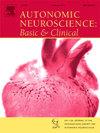Diencephalic and brainstem circuit mechanisms underlying autonomic cardiovascular adjustments to exercise: Recent insights from rodent studies
IF 3.2
4区 医学
Q2 NEUROSCIENCES
引用次数: 0
Abstract
Autonomic cardiovascular adjustments to exercise, essential for meeting the increased metabolic demands of exercising skeletal muscle, are regulated by motor volition-driven neural activation, i.e., central command. The contribution of brain mechanisms to these adjustments has been suggested for more than a century, yet the functional brain architecture remains incompletely understood. This article discusses recent findings primarily obtained from rodent studies utilizing advanced experimental tools, particularly those enabled by genetic engineering, such as optogenetics and viral neural tracing, to elucidate the diencephalic and brainstem circuits responsible for autonomic cardiovascular adjustments during voluntary exercise. Particular attention is paid to the central neural pathways and specific neuronal populations involved in transmitting central command signals, that drive not only somatic muscular activity but also autonomic cardiovascular responses. The uncovered diencephalic and brainstem circuits are relevant to understanding the brain substrate of central command, which is essential for maintaining cellular homeostasis and enhancing physical performance. Future studies and potential subjects for further investigation to deepen our understanding of the brain mechanisms underlying autonomic cardiovascular regulation are also discussed.
间脑和脑干回路机制对运动的自主心血管调节:来自啮齿动物研究的最新见解
自主心血管对运动的调节,对于满足骨骼肌运动增加的代谢需求是必不可少的,是由运动意志驱动的神经激活,即中央命令来调节的。大脑机制对这些调整的贡献已经提出了一个多世纪,但大脑的功能结构仍然不完全清楚。本文主要讨论了利用先进实验工具进行啮齿动物研究的最新发现,特别是那些通过基因工程(如光遗传学和病毒神经追踪)实现的发现,以阐明在自愿运动期间负责自主心血管调节的间脑和脑干回路。特别关注的是中枢神经通路和特定的神经元群参与传递中枢指令信号,不仅驱动体细胞肌肉活动,而且自主心血管反应。间脑和脑干回路的发现与理解中枢指令的脑基质有关,而中枢指令对于维持细胞稳态和提高身体机能至关重要。本文还讨论了未来的研究和进一步研究的潜在主题,以加深我们对自主心血管调节的大脑机制的理解。
本文章由计算机程序翻译,如有差异,请以英文原文为准。
求助全文
约1分钟内获得全文
求助全文
来源期刊
CiteScore
5.80
自引率
7.40%
发文量
83
审稿时长
66 days
期刊介绍:
This is an international journal with broad coverage of all aspects of the autonomic nervous system in man and animals. The main areas of interest include the innervation of blood vessels and viscera, autonomic ganglia, efferent and afferent autonomic pathways, and autonomic nuclei and pathways in the central nervous system.
The Editors will consider papers that deal with any aspect of the autonomic nervous system, including structure, physiology, pharmacology, biochemistry, development, evolution, ageing, behavioural aspects, integrative role and influence on emotional and physical states of the body. Interdisciplinary studies will be encouraged. Studies dealing with human pathology will be also welcome.

 求助内容:
求助内容: 应助结果提醒方式:
应助结果提醒方式:


